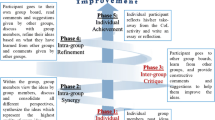Abstract
This article presents the experience of using blended learning methods and digital technologies to organize the educational process at Sumy State University. Based on the experience of using a combination of classical models of blended learning and interactive digital technologies in the educational process, a unified complex model has been proposed. The classic model of a flipped classroom is integrated with project approach to provide the collaborative problem-solving methods in the proposed model. The group-project approach for solving collective tasks is described step by step. The purpose of the research is to elaborate the complex structure of the blended learning model, including the educational load distribution, which will meet the requirements for teaching multiple subjects and different disciplines.
Access this chapter
Tax calculation will be finalised at checkout
Purchases are for personal use only
Similar content being viewed by others
References
Kluzer, S., Priego, L. P., Gomez, S C.: DigComp into Action - Get inspired, make it happen. Publications Office of the European Union. https://publications.jrc.ec.europa.eu/repository/bitstream/JRC110624/dc_guide_may18.pdf. Accessed 15 Mar 2020
Cabinet of Ministers of Ukraine: Regulation No. 386-p, Strategy for the Development of the Information Society in Ukraine. https://zakon.rada.gov.ua/laws/show/386-2013-%D1%80. Accessed 17 Apr 2020
Brolpito, A.: Digital Skills and Competence, and Digital and Online Learning. ETF European Training Foundation, Turin (2018)
Law of Ukraine: No. 1556-VII, On Higher Education. https://zakon.rada.gov.ua/laws/show/1556-18. Accessed 21 Mar 2020
Gorbunova, L., Debych, M., Zinchenko, V.: Higher Education Internationalization in Ukraine: Guidelines. IHE NAESU of Ukraine, Kyiv (2016)
Ministry of Education and Science of Ukraine: Higher Education Reform Strategy. https://osvita.ua/doc/files/news/438/43883/HE_Reforms_Strategy_11_11_2014.pdf. Accessed 19 Jan 2020
Smith, B., Brame, C.: Blended and Online Learning. https://cft.vanderbilt.edu/guides-sub-pages/blended-and-online-learning/#research. Accessed 03 Jan 2020
Korotun, O.: Methodological bases of blended learning in the higher education. Inf. Technol. Educ. 3(28), 117–129 (2016)
Krasulia, A.: The convergence of technology, pedagogy, and language learning. In: Shudlo, S., Zabolotna, L. (eds.) IV International Scientific Conference “Implementation of European Standards into Ukrainian Educational Research” 2020, pp. 80–83. Trek-LTD, Drogobych (2020)
Krasulia, A., Saks, K.: Students’ perceptions towards mobile learning in an English as a foreign language class. In: IEEE 20th International Conference on Advanced Learning Technologies Proceedings. https://ieeexplore.ieee.org/abstract/document/9155750. Accessed 18 Sep 2020
Romanovskyi, O.: Development Factors and Directions for Improving Distance Learning in Higher Education System of Ukraine. https://journal.iitta.gov.ua/index.php/itlt/issue/view/103. Accessed 20 Jan 2020
Castro, R.: Blended learning in higher education: trends and capabilities. Educ. Inf. Technol. 24, 2523–2546 (2019)
Alammary, A., Sheard, J., Carbone, A.: Blended learning in higher education: three different design approaches. Australas. J. Educ. Technol. 30(4), 440–454 (2014)
Mozelius, P., Hettiarachchi, E.: Critical factors for implementing blended learning in higher education. ICTE J. 6(1), 4–18 (2017)
Teach Though staff: 12 of The Most Common Types of Blended Learning. https://www.teachthought.com/learning/12-types-of-blended-learning. Accessed 15 Nov 2019
Bonk, C., Graham, C., Cross, J., Moore, M.: The Handbook of Blended Learning: Global Perspectives, Local Designs. https://www.researchgate.net/publication/26872610_The_Handbook_of_Blended_Learning_Global_Perspectives_Local_Designs. Accessed 4 Mar 2020
Sagenmüller, I.: 6 types of flipped classroom to innovate in higher education. https://www.u-planner.com/en-us/blog/flipped-classroom-six-types. Accessed 16 Mar 2019
O’Flaherty, J., Phillips, C.: The use of flipped classrooms in higher education: a scoping review. https://www.sciencedirect.com/science/article/abs/pii/S1096751615000056. Accessed 15 Mar 2020
Wang, K., Zhu, C.: MOOC-based flipped learning in higher education: students’ participation, experience and learning performance, https://educationaltechnologyjournal.springeropen.com/articles/10.1186/s41239-019-0163-0#citeas. Accessed 15 Mar 2020
Al Zahrani, A.M.: From passive to active: the impact of the flipped classroom through social learning platforms on higher education students’ creative thinking. Br. J. Educ. Technol. 6(46), 1133–1148 (2015)
Lapyhin, Y.: Active Learning Methods. Textbook and Workshop, Urait, Moscow (2015)
Buzan, T., Buzan, B.: Superthinking. Popurri, Minsk (2014)
Marchenko, A., Antypenko, V., Vashchenko, S., Fedotova, N., Chybiriak, Y.: Aspects of implementation the digital technologies into the educational process. In: IX International Scientific and Practical Conference “Information Control Systems and Technologies”, pp. 73–75. Ekologiya, Odessa (2020)
Belbin, R.: Team Roles at Work. Elsevier, Oxford (2010)
Lopes, A.P., Soares, F.: Flipping a mathematics course, a blended learning approach. In: Proceedings of INTED2018 Conference 2018, pp. 3844–3853. Valencia, Spain (2018)
Author information
Authors and Affiliations
Corresponding author
Editor information
Editors and Affiliations
Rights and permissions
Copyright information
© 2021 Springer Nature Switzerland AG
About this paper
Cite this paper
Marchenko, A., Antypenko, V., Vashchenko, S., Fedotova, N., Chybiriak, Y., Krasulia, A. (2021). A Complex Model of Blended Learning: Using a Project Approach to Organize the Educational Process. In: Lopata, A., Gudonienė, D., Butkienė, R. (eds) Information and Software Technologies. ICIST 2021. Communications in Computer and Information Science, vol 1486. Springer, Cham. https://doi.org/10.1007/978-3-030-88304-1_21
Download citation
DOI: https://doi.org/10.1007/978-3-030-88304-1_21
Published:
Publisher Name: Springer, Cham
Print ISBN: 978-3-030-88303-4
Online ISBN: 978-3-030-88304-1
eBook Packages: Computer ScienceComputer Science (R0)




